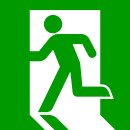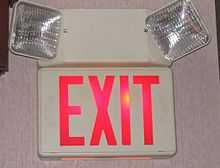Exit sign

.svg.png)



An exit sign is a device in a public facility (such as a building, aircraft or boat) denoting the location of the closest emergency exit in case of fire or other emergency.
Most relevant codes (fire, building, health or safety) require exit signs to be permanently lit.
Exit signs are designed to be absolutely unmistakable and understandable to anyone. In the past this generally meant exit signs that show the word "EXIT"[2] or the equivalent in the local language, but increasingly exit signs around the world are in pictogram form, with or without text supplement.[3]
History


Early exit signs were generally either made of metal and lit by a nearby incandescent light bulb[4] or were a white glass cover with EXIT written in red that fit directly over a single-bulb light fixture. The inherent flaws with these designs were that, in a fire, the power to the light often failed. In addition, the fixtures could be difficult to see in a fire where smoke often reduced visibility, despite being relatively bright. The biggest problem was the exit sign being hardly distinguishable from an ordinary safety lighting fixture commonly installed above doors in the past. The problem was partially solved by using red-tinted globes instead.
Better signs were soon developed that more resembled today's modern exit sign, with an incandescent bulb inside a rectangular-shaped box that backlit the word "EXIT" on one or both sides. Being larger than its predecessors, this version of the exit sign solved some of the visibility problem. The sign was only useful as long as main power remained on.
As battery-backup systems became smaller and more efficient, some exit signs began to use a dual-power system. Under normal conditions, the exit sign was lit by main power and the battery was in a charge state. In the event of a power outage, the battery would supply power to light the sign. It continued to discharge until main power returned to the unit or the battery was no longer able to provide sufficient power to light the sign. Early battery-backup systems were big, heavy, and costly.[5] Modern systems are lightweight, can be installed virtually anywhere, and are integrated into the fixture, rather than requiring a separate box. As batteries improved, so did the amount of time that a fixture could remain lit on batteries.
While exit signs were more visible due to large letters, even a 60-watt bulb shown through a plastic or glass cover (see image), could appear somewhat dim under certain conditions. With the development of fluorescent lamp and light-emitting diode technology, exit signs could be made even brighter to show up in the limited visibility of a fire situation, or use less electricity. LED signs combine a large number of bright light-emitting diodes to illuminate the sign from inside. Fluorescent lamps work in the same way as incandescent bulbs, back-lighting both sides of an exit fixture from within. Because an exit sign is constantly lit, fluorescent bulbs need to be changed more often than LEDs, although the almost nonexistent on/off cycles extend the life of fluorescent lamps significantly. Generally, LEDs have a very long life, and may last for 10 years or more of continuous use, although the brightness may diminish. LEDs aren't usually brighter than incandescents, but consume much less electricity. Incandescent bulbs are still in use, because they are cheap and common, even though they use more electricity and require more or less frequent replacement. Bulbs lit 24/7 will have a greatly extended lifespan.
In recent years, radioluminescent and phosphorescent signs that require no electricity have also been developed. Radioluminescence uses the radioactive decay of tritium to light the sign,[6] while phosphorescence uses light-emitting phosphors to glow in the dark. While both of these signs meet California State Fire Marshall standards, where practical, electricity is used in the vast majority of signs.
Modern installations


Most exit signs in the world, except in countries such as the US, Canada, Australia, Hong Kong, Philippines, and Singapore are of pictogram type. Australia and Singapore have made changes to their respective life safety codes in the direction of pictogram use. In the US, New York City has endorsed a new code requiring high rises to have glow in the dark exit signs with a pictogram (ISO). In Thailand, most exit signs are in any running-man pictogram (ISO).
Modern exit signs in the United States and Canada can be seen over every path to an exit in commercial and large residential buildings that comply with fire code. Certain circumstances, such as the year a building was built, may leave it exempt from some of these codes. In most situations, the owner of the building complies regarding exit signs. This is especially true in older buildings that serve as multiple residences, such as apartment buildings, hotels, and campus dormitories. Modern fixtures are usually in a rugged plastic or metal housing securely bolted to the wall or ceiling. The signs have the word EXIT, or a picture representing exit, on both sides. Single-sided signs are also available for wall-mount installations. The signs often have metal or plastic knock-outs which can be removed so that an arrow is also lit pointing left or right.
Many modern exit signs are combined with other safety devices, such as emergency floodlighting, as shown above. Exit signs draw a relatively small amount of power, and can generally be added onto any existing electrical circuit without adverse effects. Modern exit signs are also, to some degree, flame retardant.
Most recently, LEC (light emitting capacitor) exit signs have come to market. Drawing only 1/4W of power with an operational life of 30+ years and far exceeding the actual 5 year life of an LED sign, LEC exit signs are a new option for architects and engineers.
Lighting
Since visibility may be reduced in a fire, due to smoke or failure of electric lighting, the sign is often permanently illuminated, usually by one of:
- Radioluminescence, self-luminous, where a phosphor coating inside a glass tube glows due to the beta decay of radioactive tritium in the tube. Radioluminescence exit signs are prohibited in US Department of Defense installations.[7]
- Photoluminescence ('glow in the dark'), Phosphorescence, where light is absorbed from the surroundings and slowly re-emitted.
- Electric light, with a local rechargeable power source.
- Electric light, with the building's emergency lighting circuits providing back-up power from a UPS or a generator in case normal power fails.
Color and design
In most regions, including the European Union, Australia, New Zealand, Japan, South Korea and China, exit signs have green lettering. (In this color scheme, red is used to show prohibited activities.) In most European countries pictograms are used in place of the word "exit". European sign directive 92/58/EEC of 24 June 1992 indicates that the signs should be green in colour indicating a safe place of exit. BS EN 1838:1999, BS 5266-7:1999 also governs the emergency lighting applications.
In United States and Canada exit signs can have either red or green lettering, but usually red. This is due to states or cities enacting building codes which specify the sign color. For example, in Maryland and Los Angeles, green is required. New York, New Jersey, and Chicago require that exit signs have red text.
The Canadian National Building codes requires "red letters on a contrasting background or white letters on a red background, at least 114 mm high with 19 mm stroke spelling EXIT or SORTIE when the sign is internally illuminated".[8]
Green fluorescent signs can be seen better in dark conditions than other colors, as the human rod cell is more sensitive to these wavelengths.[9][10]
Newly installed exit signs in Australia are green with white "running man" figure (AS2293). Canada's 2010 National Building Code, released in November 2010, also calls for a switch from the North American red EXIT/SORTIE signs to the international ISO 'green running man' signs, but in airports in Canada the signs must have French and English (CAN/ULC-S572). It is expected to be adopted into the codes of each province within a few months.[11]
See also
| Look up exit sign in Wiktionary, the free dictionary. |
References
| Wikimedia Commons has media related to Exit signs. |
- ↑ Carss, Barbara (October 2010). "Traditional Signs to EXIT in Favour of the Running Man". Canadian Property Management.
- ↑ The English word "exit" comes directly from the Latin word meaning "(he or she) goes out.
- ↑ Turner, Julia (2010-03-09). "The Big Red Word vs. the Little Green Man: The international war over exit signs.". Slate.
- ↑ http://www.exitsignwarehouse.com/exit-signs-history.html
- ↑ http://www.exitsignwarehouse.com/exit-signs-history.html
- ↑ http://www.nrc.gov/reading-rm/doc-collections/fact-sheets/fs-tritium.html
- ↑ Unified Facility Criteria (UFC) 3-600-01
- ↑ http://oee.nrcan.gc.ca/publications/equipment/lighting/section11.cfm?attr=4
- ↑ Stryer, L (2002). Biochemistry. New York: W H Freeman. pp. 32.3.1.
- ↑ Bowmaker, J K; Dartnell (1980). "Visual pigments of rods and cones in a human retina". Journal of Physiology 298: 501–511. PMC 1279132. PMID 7359434.
- ↑ Carss, Barbara (October 2010). "Traditional Signs to EXIT in Favour of the Running Man". Canadian Property Management.